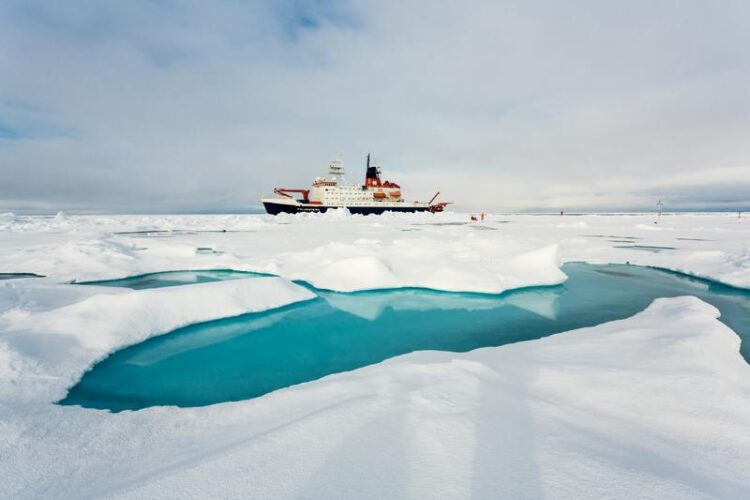Eyewitnesses to Arctic Change

Polarstern expedition to the central Arctic in 2012
(c) Alfred-Wegener-Institut/Stefan Hendricks
On Thursday, RV Polarstern is scheduled to set off from Tromsø, Norway, towards the North Pole. For two months, a good fifty scientific expedition participants will explore the Arctic in transition as sea ice extent reaches its annual minimum in September. They will explore the biology, chemistry and physics of sea ice as well as the effects of sea ice retreat on the entire ocean system from the surface to the deep sea. Eleven years ago, Antje Boetius was part of the largest ever sea ice minumum in the Arctic and its consequences for life in the deep sea. Now she is returning with her team to compare the state of the Arctic today – also with the data from the MOSAiC expedition.
“I am very excited to see how sea ice and ocean life have changed over the last decade,” says Antje Boetius. “In 2012, we were on site during the lowest documented summer sea ice extent to date and were able to see significant impacts on the entire ecosystem of the central Arctic Ocean, down to over four kilometres of water depth,” explains the Director of the Alfred Wegener Institute, Helmholtz Centre for Polar and Marine Research (AWI). “At the moment, I am monitoring the sea ice situation at www.meereisportal.de particularly intensively. We don’t yet know whether a new minimum will be reached, given the globally hot year 2023 and the fact that the sea ice in Antarctica is at a record low.”
The head of the sea ice physics team and MOSAiC expert Dr Marcel Nicolaus reports: “The ice currently covers an area of just under 7.5 million square kilometres, similar to that of the past two years. This means that there is still about one million square kilometres more ice than in 2012. However, the summer melt is in full swing, and the wind in particular will determine how the porous, brittle ice continues to be distributed in the coming weeks.”
The expedition team is investigating in detail how the composition of the sea ice is changing on site: Helicopter-towed sensors are used to measure sea ice thickness, ice cores allow the sea ice composition to be analysed and algae living in the ice to be studied. An underwater robot measures how much light passes through the ice into the ocean when its surface is still covered by snow or already by melt water ponds. The light is available to micro algae (phytoplankton) as a source of energy for photosynthesis, which live in the upper water layers. What happens to the carbon they bind is being researched (micro-)biologically, chemically and physically from the water surface to the deep-sea floor. The planktologists on board want to follow the path of life directly under the ice into the deep sea, for which they bring out various camera systems as well as autonomous samplers.
Several so-called ice stations are planned for the work: “The ship docks at a floe, then the ice researchers go onto the floe, we deploy various robots and free-fall devices and, in parallel, we look at the creatures at the bottom with the zoologists, more than 4000 metres below. In this way, we recognise connections in all levels of the ocean from the sea ice to the seabed,” explains Antje Boetius. In doing so, the team is returning to the same working areas as in 2012 for comparative studies: to the particularly productive marginal ice zone and regions with perhaps still perennial ice cover in the central Arctic. A range of proven but also new technologies will be used for the work, for example lander systems, deep-sea crawlers and the Ocean Floor Observation and Bathymetry System (OFOBS) developed at the AWI. The return takes place after the summer ice melt, when the autumn sea ice formation begins.
Among the participants is a camera team from UFA Documentary GmbH, which is filming the expedition. The television documentary, which is being produced in cooperation with NDR, is scheduled to be broadcast on ARD at the turn of the year. Already during the expedition, interested parties can gain impressions from on board in the radio program of Radio Bremen and of course also follow the expedition in the Polarstern app and on the social media channels of the Alfred Wegener Institute. Polarstern is scheduled to return to its home port of Bremerhaven on 1 October.
Weitere Informationen:
http://www.awi.de/en/about-us/service/press/single-view/augenzeugen-des-arktisch… – further images
Media Contact
All latest news from the category: Life Sciences and Chemistry
Articles and reports from the Life Sciences and chemistry area deal with applied and basic research into modern biology, chemistry and human medicine.
Valuable information can be found on a range of life sciences fields including bacteriology, biochemistry, bionics, bioinformatics, biophysics, biotechnology, genetics, geobotany, human biology, marine biology, microbiology, molecular biology, cellular biology, zoology, bioinorganic chemistry, microchemistry and environmental chemistry.
Newest articles

Innovative 3D printed scaffolds offer new hope for bone healing
Researchers at the Institute for Bioengineering of Catalonia have developed novel 3D printed PLA-CaP scaffolds that promote blood vessel formation, ensuring better healing and regeneration of bone tissue. Bone is…

The surprising role of gut infection in Alzheimer’s disease
ASU- and Banner Alzheimer’s Institute-led study implicates link between a common virus and the disease, which travels from the gut to the brain and may be a target for antiviral…

Molecular gardening: New enzymes discovered for protein modification pruning
How deubiquitinases USP53 and USP54 cleave long polyubiquitin chains and how the former is linked to liver disease in children. Deubiquitinases (DUBs) are enzymes used by cells to trim protein…



